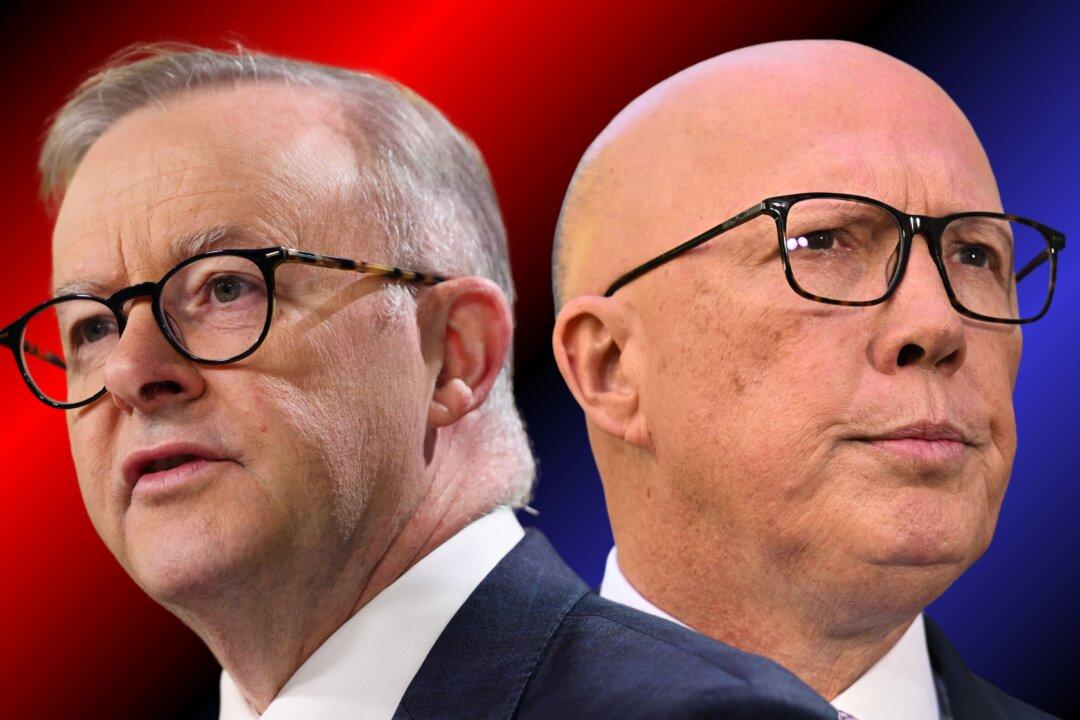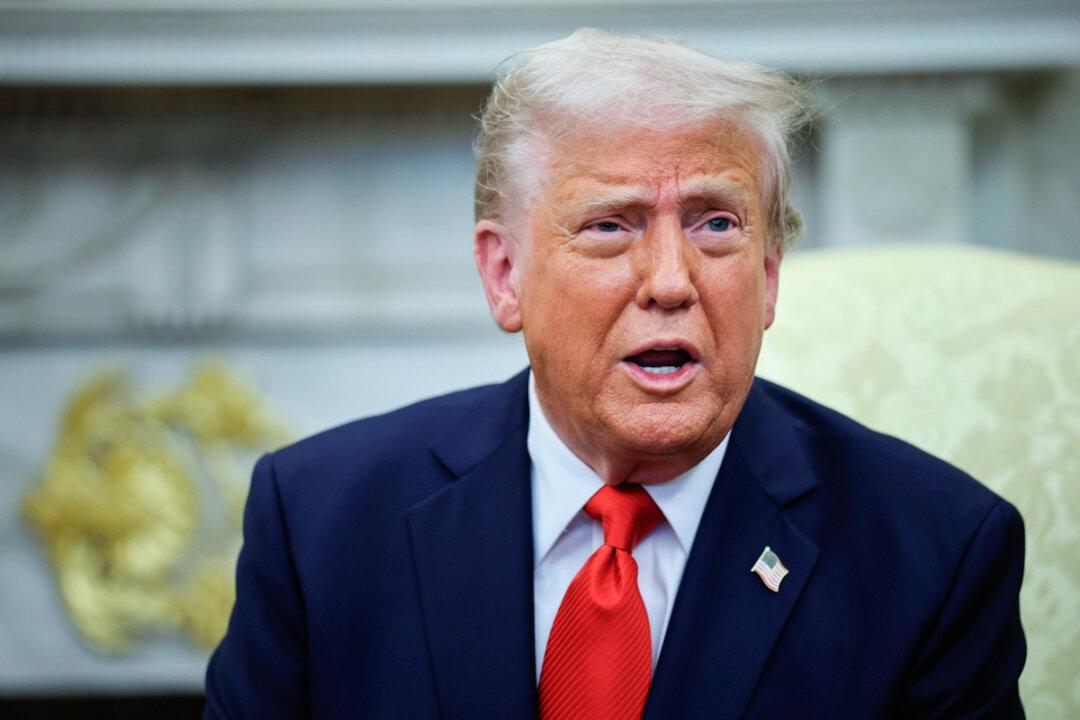Prime Minister Anthony Albanese and Opposition Leader Peter Dutton faced off in their first leaders’ debate ahead of the May 3 election, reiterating their party plans for cost of living, health, education, energy, immigration and foreign policy.
Albanese opened by citing falling inflation (2.4 percent), steady jobs growth, and rising wages.
“We’ve created a million jobs. Interest rates are falling. This is the time to move forward,” he said.
He pitched tax cuts for 14 million Australians, stronger Medicare, free TAFE and domestic manufacturing under Labor’s “Future Made in Australia” plan.
Dutton countered with a bleaker view.
“It’s been a tough three years,” he told the Sky News studio audience. “Groceries are up 30 percent, power bills are up $1,300—against what the PM promised, a $275 cut.”
He pitched the Liberal Party’s 25-cent-a-litre fuel excise cut, investment in gas, and energy reforms.
“It will help families, pensioners, and the economy.”
Cost of Living Front and Centre
Dutton asked for a show-of-hands from the studio audience for those struggling with living costs, with many raising their hands.Prime Minister Albanese was pressed on why he wouldn’t match the Coalition’s fuel tax cut.
“Fuel excise will disappear in a year, like last time,” he said, insisting his government preferred permanent reforms such as tax cuts, free TAFE, student debt relief and energy rebates.
“Prescription prices are down to $25.00, capped at $7.70 for pensioners. We’ve delivered cheaper childcare. All of this was opposed by the Coalition.”
Dutton warned excessive spending would fuel inflation.
Work-From-Home vs Fuel Rebate
Albanese took aim at Dutton’s public servant work-from-home policy that he later backflipped on, saying it undermined his own fuel excise rebate.“They offer cheaper petrol, then force people to commute more. We enshrined the right to bargain for remote work,” Albanese said.
Dutton responded: “Our policy only applied to Canberra public servants. The PM misrepresented it.”
He said his goal was efficient use of taxpayer money, noting the size of the Canberra public service had grown by 20 percent.
“Flexible work is fine. We’ve always said that.”
Nuclear Energy vs Renewables
The same old story. Albanese challenged Dutton’s nuclear plan.“You’re proposing $600 billion for just 4 percent of power by the 2040s. What will you cut to pay for it?”
Dutton called the figure dishonest, citing a report that placed capital costs closer to $120 billion.
“Our plan, costed by Frontier Economics, is 44 percent cheaper than Labor’s $600 billion renewables-only plan.”
He pointed to France and China who both rely heavily on nuclear, contrasting it with Albanese’s failed power bill promise.
“He said bills would drop by $275. They’re up $1,300.”
Albanese said nuclear was economically unviable.
“If it stacked up, private investors would fund it. Instead, we’re backing renewables, batteries, and gas to keep prices down.”
Dutton advocated expanding domestic gas supply to support manufacturing and reduce prices.
“Independent analysis shows we could cut gas prices by 15 percent, easing pressure across the economy.”
Albanese accused him of gaslighting.
Medicare Gap Sparks Fireworks
A Parramatta woman said she was paying $70-$80 in out-of-pocket fees despite bulk billing. Albanese cited the government’s $8.5 billion investment and tripling of bulk billing incentives.“All you need is your Medicare card, not your credit card,” he said.
Dutton responded by asking the woman whether she needed to bring her banking card when she saw the GP, and she “yes.”
The opposition leader said this was a widespread occurrence.
“Out-of-pocket costs have surged under Labor. Bulk billing is down to 77 percent.”
He pledged $9.5 billion for health and $400 million to train more GPs.
Schools and Universities
A teacher asked about public school funding. Albanese cited his $14.6 billion deal with all states.“In 2014, $30 billion was ripped out of schools,” he said, blaming the Coalition.
Dutton denied cuts.
“Funding didn’t increase as much, but it wasn’t cut,” he said, calling Labor’s claim a scare campaign.
On university fees, a voter asked if international students were pushing domestic fees higher. Dutton said the system was broken.
“One student unit per 42 arrivals — it’s unsustainable.”
He promised a migration cap and $5 billion to build 500,000 homes. Albanese defended his record.
Middle East Flashpoint
A voter asked if Australian taxes were supporting violence in Gaza. Albanese rejected the premise.“There is no Australian weaponry involved. That’s just not the case,” he said.
He reaffirmed support for a two-state solution and U.N. calls for a ceasefire.
“I want to see both Israelis and Palestinians live in peace.”
Dutton emphasised solidarity with Israel.
Solar Rebates and Energy Equity
Asked about improving solar incentives, Albanese said Labor would provide 30 percent rebates for battery storage.“We invented solar tech, but we don’t manufacture panels. That must change.”
Dutton backed solar but attacked the rebate:
“Lower-income Australians shouldn’t subsidise batteries for people like me.”
Quickfire Clarifications
The debate also featured a series of quickfire questions demanding brief clarifications from both leaders.Peter Dutton ruled out any healthcare cuts, saying, “We’ll legislate it.” Dutton also confirmed there would be no changes to work-from-home arrangements.
Albanese reaffirmed his commitment to AUKUS, stating he would not link national defence to U.S. tariff negotiations.
On The Voice to Parliament, Albanese said he would not pursue legislation after the referendum defeat.
Closing Arguments
Albanese: “Peter says no health cuts—like in 2013, before they slashed health, education and the ABC. We’ve governed responsibly, improved the budget, supported households.”Dutton: “30,000 small businesses gone. 16 months wasted on The Voice. Families are hurting. Labor can’t manage money. We’ll bring back hope, home ownership, and economic strength.”
The first leaders’ debate can be encapsulated by Albanese’s message of stability and investment, and Peter Dutton’s pitch for economic relief and fiscal restraint.






